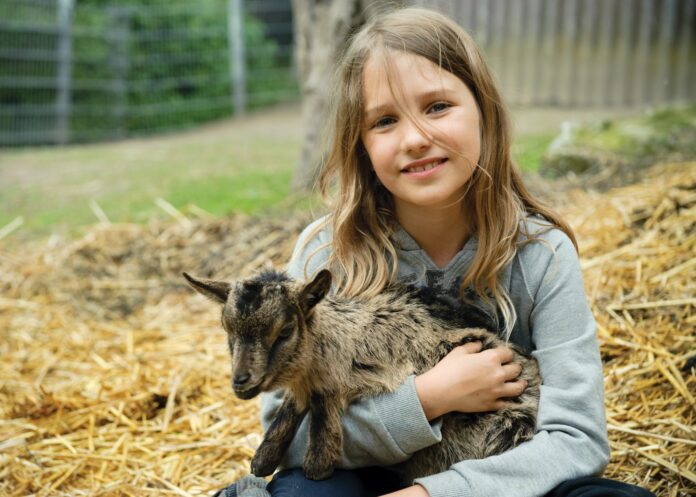AUBURN UNIVERSITY, Ala. – Goats are becoming popular pets for people living in urban as well as rural and suburban communities. Goat owners in urban and suburban areas, for example, raise goats in their backyards as well as on empty lots. Regardless of where you live, however, understanding goat behavior, becoming familiar with different goat breeds and developing skills in goat care are critical when selecting pet goats.
Goat behavior
Goats have several different types of behaviors that make up their unique personalities. Important behaviors to pay attention to are:
- resting
- feeding
- socializing
- fighting
- restlessness
Resting
A goat will prefer to rest or ruminate with its neck and head on the floor with front legs and hind legs stretched. They may also rest with the belly and front legs positioned under their neck while their head is placed on the hind legs. The last typical resting position is the animal lying on its side and with its limbs stretched but crossed.
Feeding
Goats are browsers. This means they prefer to eat forages with their neck stretched up rather than looking down for their food. Due to this tendency, they prefer weeds and underbrush to grass. When fed in a trough, animals prefer to take small breaks to consume water and then return to the trough.
Goats will need forage supplementation if there is insufficient pasture. Goats consume 2-4 pounds of forage a day, or they can consume up to 3% of their body weight. They also need to take in 1-3 gallons of water per day.
Socializing
In a play-type social behavior, goats may rub their horns against their peers in an up-and-down motion and with their necks or lightly collide with their horns. They may also lie next to or lean onto another goat to rest and socialize. Goats in this position may shake their head without an aggressive act.
Goats are also herding animals. While they may seem okay by themselves, they will have a higher quality of life with a friend or two.
Fighting
Fighting is the main aggressive behavior between goats. In usual fighting, heads will be lowered and horns will collide with each other. They may continue to back up and charge again. Goats may also raise their front legs off the floor while the hind legs remain on the ground, then clash their horns into the horns of the other animal. A goat may encourage an unwilling goat to fight by hitting its horns against the flank or ribs of another goat that may not be interested in fighting at the time.
Restlessness
The last behavior, restlessness, is the desire to leave. A goat may exhibit this behavior by pushing against a stall wall or door, or by constantly moving back and forth. This usually happens because of boredom or lack of mental stimulation. These animals are meant to roam and keeping them stalled all the time may allow this behavior to become prevalent and destructive to the animal and the stall.
Shelter and predator control
If the pet goats are always outside, shade shelters will be necessary. Shade shelters are not only to shelter them from the sun but also the rain. Goats dislike rain and will run to the nearest area of protection when storms approach. Shade shelters are usually three-sided to protect them from the elements. Shade shelters need to be kept clean to prevent hoof-rot.
Predators are another problem. Closer to urban areas stray dogs will be the biggest threat. The occasional coyote and raccoon might also cause problems. These issues can be best prevented with proper fencing. Other options include guarding animals to eliminate threats if necessary. Goats are prey animals and predators will keep watch to see when best to strike, so preventing them is key to long-healthy lives of your pets.
Pet goat care management
Like other pets, goats need yearly vaccinations and other care that is specific to small ruminants. Although goats are prone to diseases, such as tetanus, enterotoxaemia, caseous lymphadenitis and pasteurellosis, talk to a vet to find out what vaccinations are recommended for goats in your region. In addition, goats will need their hooves trimmed regularly.
Breed options for pet goats
There are several different breeds of goats that are ideal for pets. For smaller areas, land dwarf breeds are recommended. These breeds include Nigerian Dwarf, Myotonic and Kinder. For larger goat breeds, check out Boers, Kikos, La Mancha or Saanen. These breeds tend to have friendly dispositions, so they make great family pets.
The Nigerian Dwarf Saanen, and La Mancha goats are three dairy goat breeds for families with an interest in collecting goat milk. The Nigerian Dwarf can produce between a pint to 3 quarts of milk per day with butterfat between 6-10%. Saanen can produce 2-3 gallons per day, but with low butterfat of 2-3%. Lastly, La Mancha is in between producing 1-2 gallons per day with around 4% butterfat. Stocking density for goats depends on the availability of forages for goats.
Conclusion
Goats can be a good option for pet animals. As with other animals, it’s important to learn breed characteristics, proper nutrition, maintenance and creating a good environment. Each pet goat may have its own individual needs and unique behavior that is learned through hands-on experience. Before purchasing any goats, find out if there are regulations against owning goats or if there are other zoning requirements where you live. In addition, visit a veterinarian to learn more about major diseases for goats that are currently present in the area.
Visit www.aces.edu for additional information about sheep and goat production management.



























